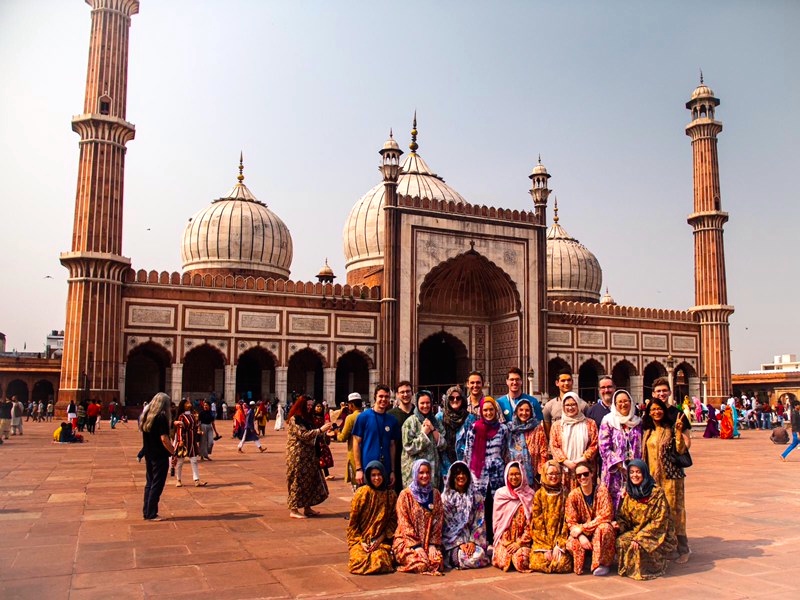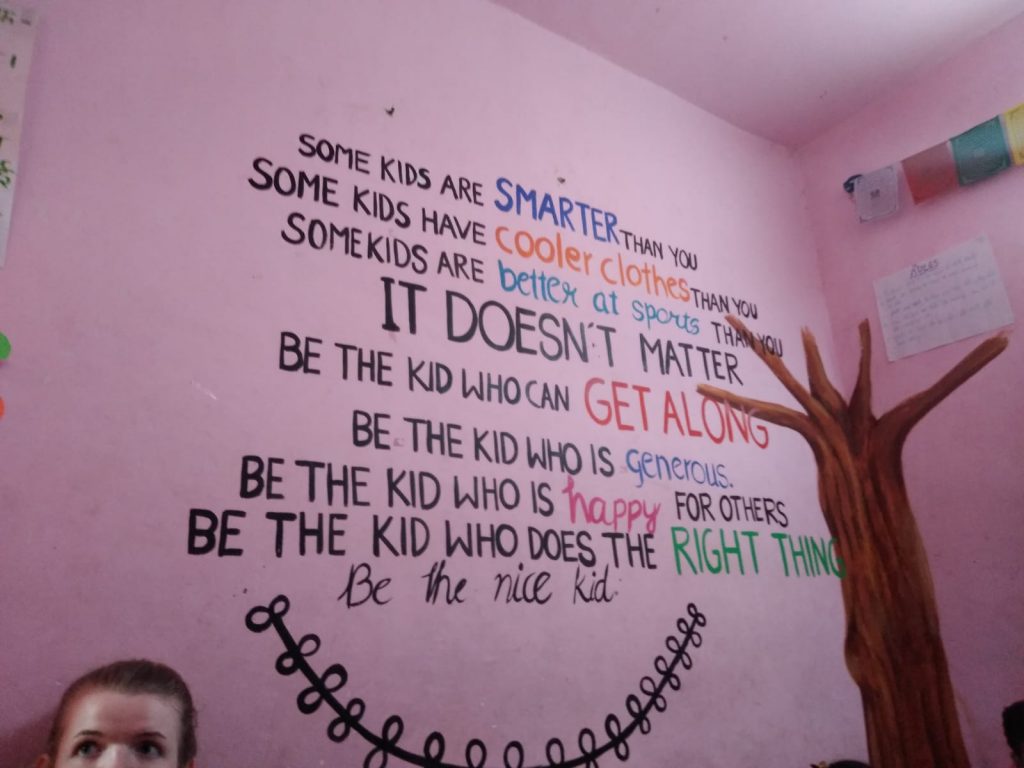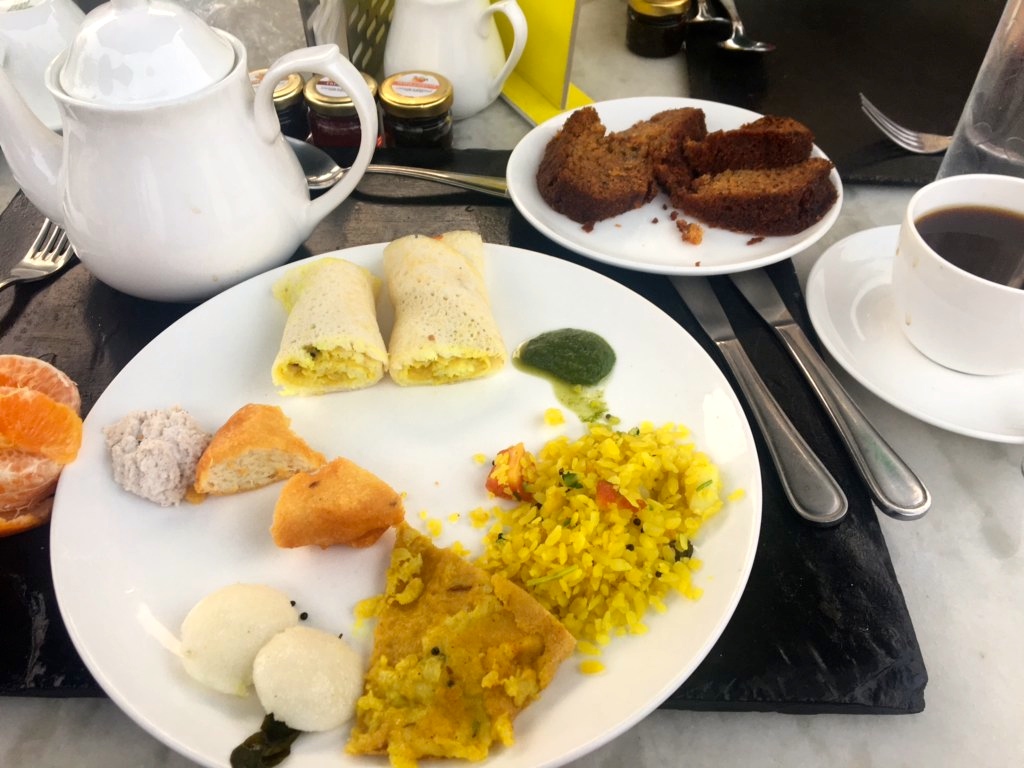By Bubba Sugarman
We groggily climbed the stairs from our rooms to the rooftop of our little hotel. The smells of Indian cooking and air pollution tickled our nostrils as we emerged onto the roof to find a beautiful space filled with tables and lined with shrubs and flowering plants. We ate a delicious sampling of flavorful traditional Indian cuisine consisting of potatoes, eggs, and fried bread.
After breakfast, we assembled outside the hotel and joined a guide from When In India Tours, a local tour company started by two Indian sisters. With our backpacks stuffed with recording equipment, we walked to the Delhi Metro. We rode the metro to Old Delhi and found ourselves outside a Jain temple. Its brightly painted red spires soared high into the smoky air. We removed our shoes and stepped into a small conference room filled with plastic lawn chairs. An old with greying hair sat behind a particle board desk. Our guide introduced him as Professor Jain, a retired Indian College professor and a devout follower of the Jain religion. He lectured us on the teachings of Jainism and led us into the open-air temple, where he explained the significance of the many idols and offerings we saw. Offerings of rice littered the temple and stuck to our feet as we traversed the maze of eloquently gilded rooms. Professor Jain explained that nonviolence was a principle teaching in Jainism as he guided us through a connected bird hospital that rehabilitated and nurtured wounded street birds.
We departed the temple and reluctantly bid farewell to Professor Jain. Braving the busy streets of Old Delhi, we weaved our way through the crowd of people to a Hindu Temple dedicated to Lord Shiva. After removing our shoes and arranging them on the curb, we climbed the marble steps of the temple. Inside, devoted Hindus clad in saffron robes sat on woven carpets, their backs against the stone walls. Our guide explained the significance of the many deities we encountered as she discussed Hindu theology. Many individuals offered small clay oil lamps to the deities as they spoke or sang prayers.

Finding our shoes once more, we mounted rickshaws and launched into traffic. Our drivers deftly maneuvered their vehicles through the busy streets as busses, cars, motorcycles, and Tuk Tuks honked and swerved around them. It was almost like an amusement park ride without the lap belt or safety grantee. Dismounting the rickshaws, we found ourselves at the foot of a set of towering red sandstone steps leading up to a mosque. Monkeys paraded across the tops of nearby shops swinging from the electrical wire and taunting one another.
We dawned shoe coverings, and the women robed themselves in loose patterned robes as we walked beneath the towering arches of the entrance. An immense red sandstone courtyard stretched before us, filled with worshipers and tourists. Three white marble domes towered above one side of the courtyard, and at each corner stood a slender minaret. In one corner of the complex, a small white marble building ordained with scrawling flowers and intricate designs stood tucked behind an iron gate. We gathered around a small window, and a Muslim man showed us a collection of religious artifacts. Among other things, he showed us pages of the Quran written by the son in law and the grandson of the prophet Mohamad as well as a single hair from the profits beard. We touched a stone indentation of the prophet’s footprint and, after a few group photos, found our way out of the mosque.

We joined our rickshaw drivers who greeted us with big smiles and broken English as they helped us into our seats. Once again, we sped through traffic and found ourselves at a local eatery. We feasted on a selection of vibrantly colored paneer and vegetable dishes paired with delicious fried breads and steamed rice. We ate and rested on the cramped top floor of the sweltering café as our jetlag tugged at our eyelids.
Soon we were swept back into our rickshaws and whisked away back toward the Jain temple. We left our rickshaw drivers with a swift farewell and made our way, ducking under tangles of electrical wires and side-stepping trash and puddles of sewage. As we ventured deeper into the network of leaning brick buildings, the streets became narrower and darker as the sunlight struggled to reach the ground. At the end of an alley, we came across a small white room. Inside, a group of laughing children ranging from four to fourteen played together, shouting and laughing joyfully. A young man in his early thirties with a bright smile and kind brown eyes welcomed us, and, after settling the children, he introduced himself. He explained that this was a home for street children who had been abandoned by their families. We played with the children, and they excitedly taught us a secret handshake that they had learned. Though our words were different, the genuine joy they expressed transcended any vocalization of thought or feeling. They asked us to share a song with them, and after a brief huddle, we dusted off a camp song, the remixed I’m a Little Teapot. With the last notes of our song reverberating in the air, the children shouted their demand for an encore. We followed two more camp songs and bid farewell to our new friends.

We stumbled through the streets once more, passing street dogs and vendors peddling their wares. Climbing a staircase, we emerged into a room full of new blue table-mounted sewing machines. Bare fluorescent bulbs lit the yellow painted room. Children played in a small room while women worked at the low tables. They shyly introduced themselves, and our guides explained that we were standing in an NGO dedicated to providing women opportunities to work outside the home. Instead of being trapped in the house, women could come to learn to sew, use the machines, and generate a menial income for themselves and their families. The women we met joyfully taught us what they had learned and showed some of our group members how to make a tote bag. We shared a cup of afternoon tea and some light snacks before departing, taking with us some bags, handfuls of snacks, and a deep respect for the selfless work of Old Delhi’s NGOs.

Once more, we traversed the bustling streets until we found the Delhi Metro. A crowded ride later, we arrived at our hotel and stumbled up the stairs to the rooftop for dinner. Our eyelids drooped as we ate a flavorful array of Indian food. We trudged off to bed and got a good night’s rest, preparing us for our next day in India.



